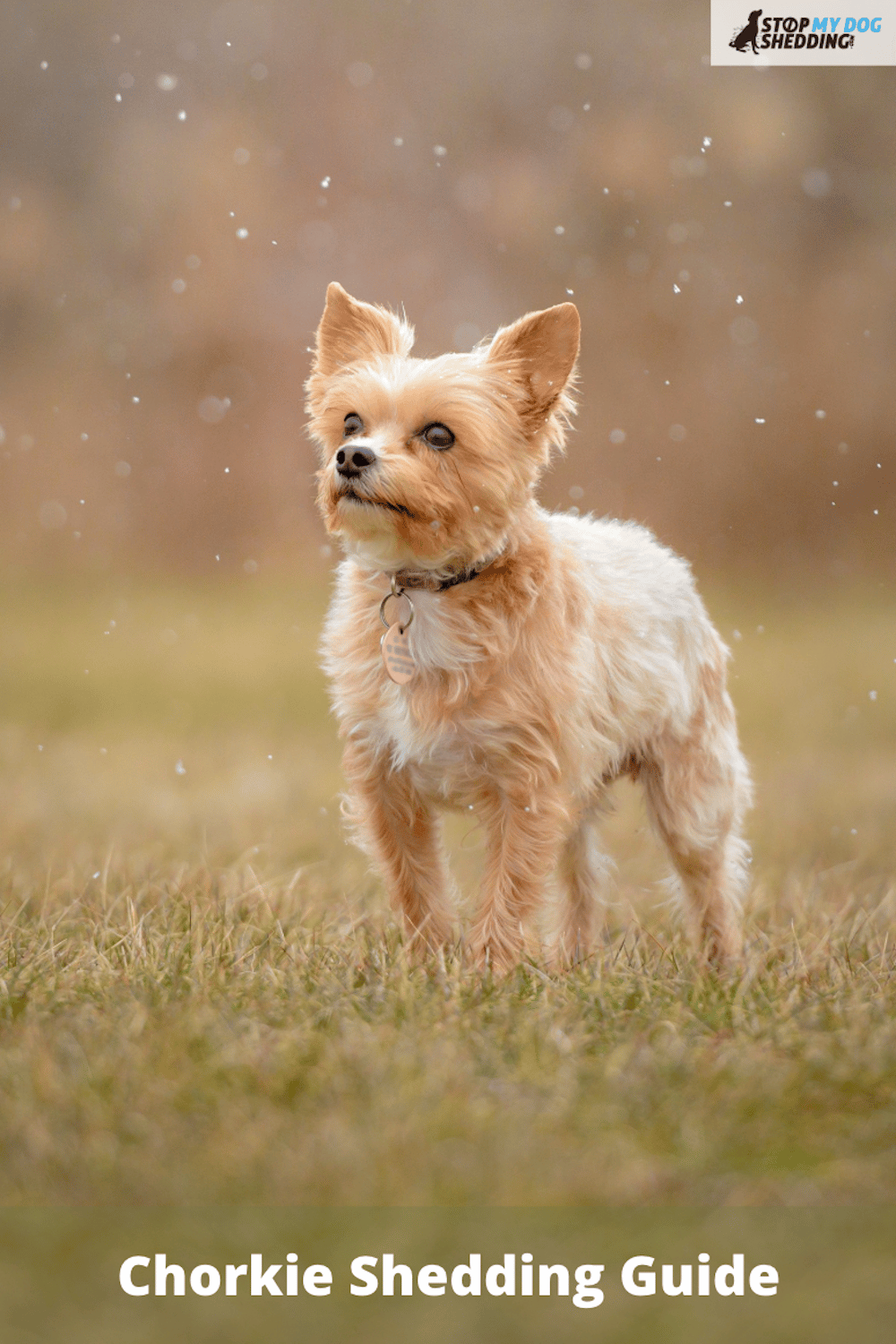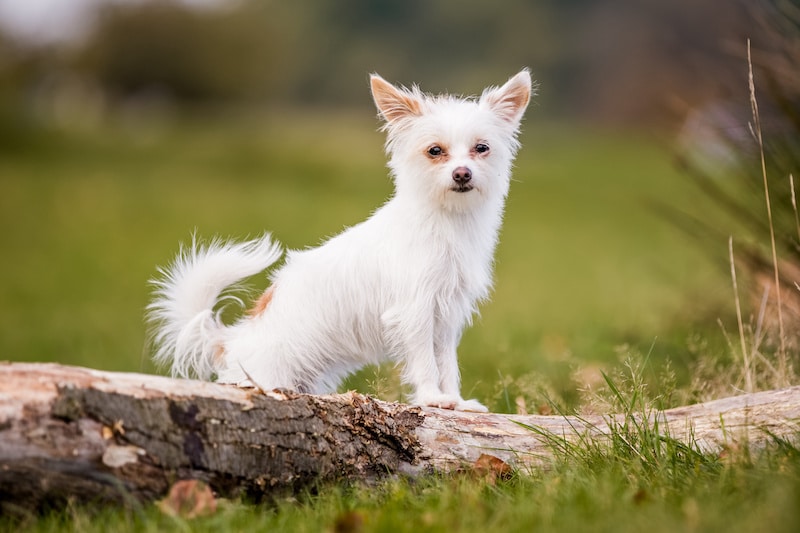The Chorkie, also known as the York Chi and Yorkiechi, is a hybrid designer dog that’s a cross between a Chihuahua and Yorkshire Terrier. With a bright temperament, this companion breed is often described as playful, outgoing, friendly, and highly trainable.
What about shedding? Chorkies are generally low-shedding overall but may shed slightly more if they take after their Chihuahua parent than their Yorkie parent because some varieties of Chihuahua are double-coated and tend to shed more with the change of seasons.
As for grooming, this can be quite an undertaking, but this too depends on the parents of the Chorkie, and you can minimize coat maintenance through proper trimming.
If you want to learn everything about the unique crossbreed that is the Chorkie, read on. Ahead, I’ll discuss how much this dog sheds, what grooming the Chorkie is like, and what this dog’s temperament is to help you decide if it’s right for you.
Chorkie Shedding
In order to understand how much your Chorkie is likely to shed, the first thing to do is look at the parents, which are the Yorkshire Terrier and the Chihuahua.
Thankfully, both of these dogs are considered low shedders, so we’re already off to a good start. But let’s look a little deeper at each parent, starting with the Chihuahua (Chi).
When most people think of Chis, their mind automatically goes to the adorable, spunky, feisty short-haired Chihuahua.
Yet that’s not the only type of coat a Chi can have. The dog might also boast a lengthier coat akin to what a Yorkie may have (but not quite as long, of course!).
Depending on which type of Chi you have, you’re getting two very different dogs.
A short-haired Chihuahua is single-coated. And while short-coated dogs are known for shedding more than breeds with longer fur, the short-coated Chi doesn’t shed excessively, which is largely thanks to its single coat.
The long-haired Chi is double-coated. This means that some Chihuahuas have an insulating undercoat and a dirt-repelling outer coat. And this variety of Chi tends to shed a bit more.
Why? Because once or twice a year, most double-coated dogs, including the long-haired Chihuahua, tend to shed more during spring and autumn in preparation for the changing seasons. This is known as seasonal shedding, and it can see the dog drop a lot more fur than usual for several weeks at a time.
So what does this mean for you as you adopt a Chorkie?
In short, it means that if you adopt a Chorkie that is predominately Chihuahua, and the parent Chihuahua is double-coated, then you are likely to have a higher shedding Chorkie than if the parent Chi is single-coated. It also means that it’s likely to shed more than if the parent is a Yorkshire Terrier (Yorkie) since, unlike Chis, those are single-coated.
Yorkies have one type of coat: long, flowing, and single layer. So, between the length of the fur and the Yorkie’s small stature, some dog owners have called the Yorkie non-shedding.
No dog is truly non-shedding, though, not even the Yorkie. So take those comments with a grain of salt. But Yorkies are very low shedding, and they don’t shed seasonally.
So, the answer to how much a Chorkie sheds ultimately comes down to its parents. As mentioned, both are low shedding, but a double-coated Chi sheds more twice a year.
So it’s best to ask the breeder about what kind of coat the parent Chihuahua has before adopting if you want to get an idea of what to expect. This is because the breeder should be able to give you some insight into the Chorkie’s parents, which can tell you if it’s likely to be double-coated or not, which can therefore help inform you on its potential rate of shedding.
Grooming Your Chorkie
Keeping a Chorkie’s coat neat is no walk in the park unless yours has mostly short-haired Chi lineage.
In that case, I’d recommend a bristle brush, as that will glide right over your Chorkie’s short, smooth fur and get the job done with no hassle.
How often do you have to brush your Chorkie if it has a shorter coat?
At least several times per week.
While it’s true that you don’t have to worry about contending with mats and tangles with a short-haired dog, regular brushing is still highly advantageous.
This is because, for one thing, you’ll pull out the Chorkie’s dead fur before it sheds. And second, you’re helping to spread your dog’s natural skin oils, which itself has a twofold benefit: making your Chorkie’s coat shine and preventing dry, itchy skin.
What about longer-haired Chorkies?
Whether a longer-haired Chorkie has the double coat of a long-haired Chihuahua or a Yorkie coat, you will need to make regular brushing a routine if it has long hair.
With its coat length, mats, tangles, and knots are a much more frequent issue for the Chorkie. So, in this case, the best approach is daily brushing with a slicker brush or a metal comb.
If your Chorkie sheds seasonally, then that’s all the more reason to brush your dog daily. It’s the only way to combat all that loose fur that’s going to come out for weeks on end.
You might also want to invest in a de-shedding tool around this time, as well as a good fur removal tool for your floors, furniture, and car.
What about trimming your Chorkie?
Well, if yours has the short coat of a Chi, then you may have to do a few snips here and there where some of the fur grows long and unruly, but nothing too much.
However, for those Chorkie owners with a strong Yorkie lineage or a double-coated Chihuahua lineage, then you may want to get more comfortable trimming your pup.
What kind of trimming you’ll need to do will come down to your personal preference as well as whether yours is just an everyday canine or a show dog.
You might wish to let your Chorkie have longer hair that you hold up with bows and clips. If so, then you’ll have to make trimming a habit, getting the hair around the eyes, the chin, the feet, and the ears so the hair is not invasive (or a tripping hazard!)
Most Chorkie owners trim their dog so that it has a cute puppy cut because, with that cut, there’s no chance of the hair falling in the dog’s eyes or face.
Here are some other cuts to try.
- Three-layer cut: The three-stack or three-layer coat features a longer topknot and facial hair that goes just under the shoulders. Then the body is trimmed to be no higher than three inches from the ground. The legs are trimmed, so the hair length is a half-inch above the ground. This precise style is better left to a groomer to do.
- Teddy bear cut: Not quite a puppy cut but close, a teddy bear cut requires rounding the Chorkie’s tail, legs, and face to give the dog a sculpted, adorable shape.
- Show trim: The show trim is for all the fancy Chorkies out there. You would cut the dog’s hair down to about a half-inch all over.
If you’re nervous about trimming your Chorkie, you can always take your favorite four-legged friend to the groomer.
Finally, you have to bathe your Chorkie. You can do this in your sink or a small basin (such as a plastic bucket) rather than your tub. But the far better approach is bathing with a proper dog grooming bath, as this can help you do a better job and cause less mess.
For best results, use a dog-friendly shampoo (like the ones on this list). And when you’re done, you can either towel-dry a shorter-coated Chorkie or, with a longer-coated Chorkie, I’d recommend air-drying and gently blotting or using a dryer designed for dogs.
About the Chorkie: All You Need to Know Before Adopting This Beautiful Hybrid Dog
Chorkies are hybrid breeds that are half Chihuahua and half Yorkie. Bred as a designer dog, the Chorkie is meant to be a companionable pet.
The Chorkie has a bright temperament and is described as playful, outgoing, friendly, highly trainable, affectionate, cheerful, smart, and very energetic.
Here is a video that has even more fun facts on the Chorkie!
If all you can offer your next pet is an apartment, the Chorkie should be right at home. This dog is only nine inches tall and weighs about 10 pounds, so they’ll love how spacious an apartment feels.
The Chorkie should ideally have both outdoor and indoor space to run and play, as this breed has a lot of energy to burn. Perhaps you can take your pup to a dog park if you don’t have a fenced-in yard. But either way, try to make sure they get enough exercise and stimulation.
What if you have other pets in the house?
Some Chorkies like being the top dog (i.e., the only dog), but many more are adaptable and will get along with other dogs if you socialize your Chorkie properly.
That said, it’s generally best that Chorkies share a household with other small breeds like it, as bigger dogs can easily hurt the Chorkie during a play session.
Chorkies don’t have a very high prey drive but still aren’t known to be great with cats. So, while not all Chorkies detest felines, this may be something to consider if you have a cat or are considering getting one down the road.
If you have kids in the house, the Chorkie is usually an amiable companion, but it depends. If the kids are young and grabby, the Chorkie can get impatient and snappy quickly. The dog is also at risk because a young child might accidentally hurt the Chorkie while playing.
Chorkies have more patience and generally have a better relationship with older children.
What about barking?
The Chorkie is quite a vocal mixed breed and seems at times to love hearing the sound of its own voice. So if you want to prevent your neighbors from lodging complaints about noise, it might be worth training your dog to be quieter from early on.
Final Thoughts
Chorkies are Chihuahua and Yorkshire Terrier crossbreeds that usually shed little, especially when the dog is single-coated. Grooming a Chorkie can be a challenge, but this too depends on its lineage, and with this pup’s big personality, perhaps you won’t mind the extra effort!













Please note: By submitting a comment using the above comment form, you confirm that you agree with the storage and handling of your data by this site as detailed in our Privacy Policy.